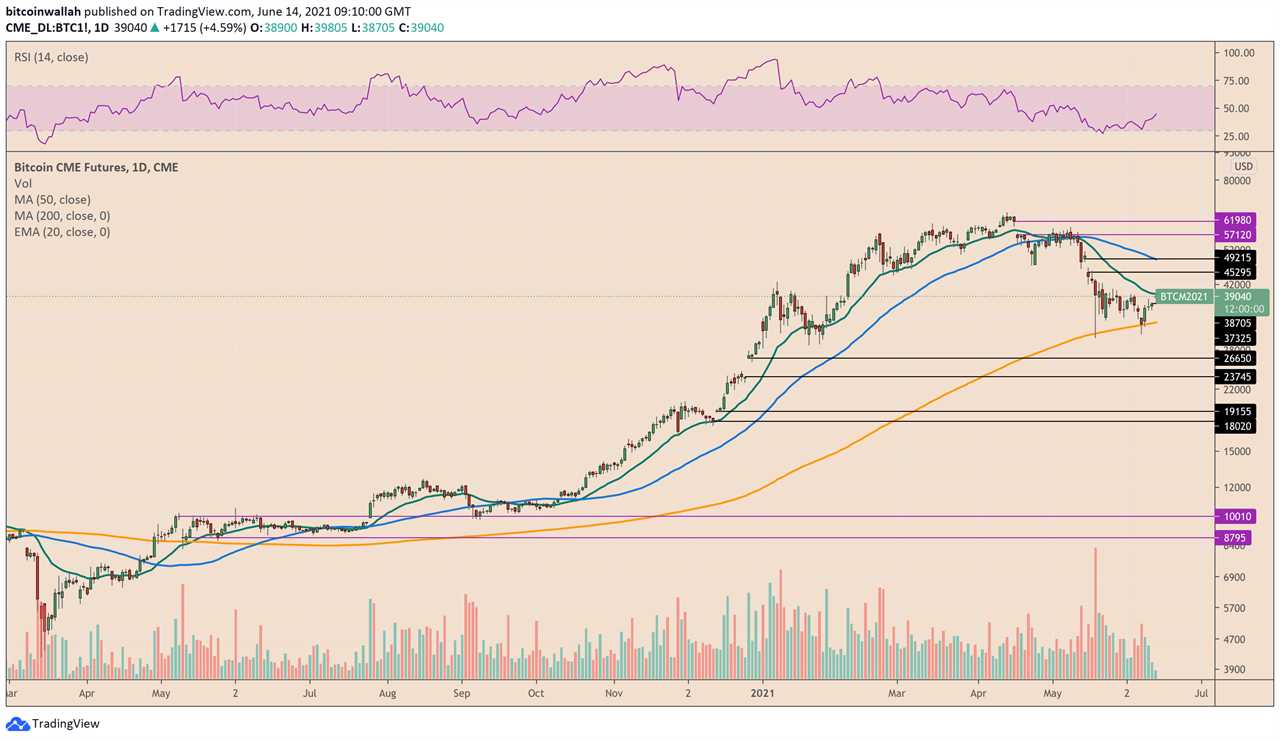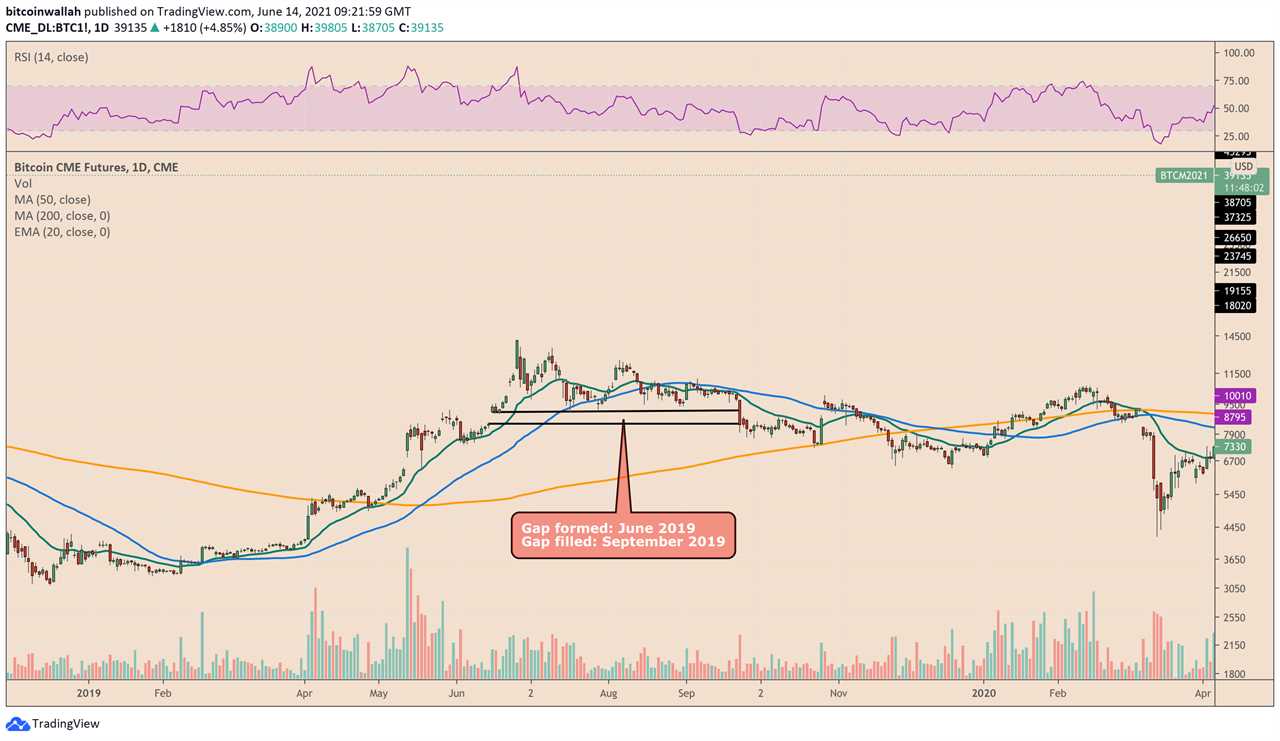
A run-up towards $40,000 in the Bitcoin market risked exhaustion as Chicago Mercantile Exchange's futures opened on Monday, June 14 with a gap of $1,575, the first since May 17.
In retrospect, the downside risks heightened due to Bitcoin's recent bearish pullbacks near the $40,000-level. Atop that, the said CME gap formed between Friday's close of $37,325 and Monday's open of $38,900, raising possibilities that the next correction would prompt Bitcoin bids to fall to at least $37,325.
That is due to a general psychological notion among traders that BTC/USD reverses its trends to fill Bitcoin futures gaps more than 90% of all time. So, for instance, traders partially filled a gap that appeared during the April 17-18 weekend session eleven days later.
Similarly, in May 2020, the missing weekend candle between $8,795 and $10,010 was filled immediately after its formation.

But throughout 2020 and entering 2021, the Bitcoin market's supersonic uptrend left many missing price candles unfilled. The last of such big gaps appeared during the long Christmas weekend last year, about $2,900-long, between $23,745 and $26,650, which remains unfilled to this date. Similarly, another unfilled CME gap between $18,020 and $19,155 dates back to early December 2020.
The maximum time traders have taken to fill a CME gap is three months — the missing price candle in focus appeared in June 2019 and was filled in September 2019.

Fundamentals < CME gap sentiments
Macroeconomic fundamentals played a huge role between June and September 2019 in keeping Bitcoin prices away from its lower CME gaps. Firstly, many investors bought Bitcoin as their haven asset as the U.S.-China trade war weighed on global growth and market sentiment.
Secondly, Facebook's foray into the cryptocurrency sector with the launch of Libra created more upside opportunities for Bitcoin.
In 2020, the Federal Reserve's open-ended expansionary policy served as a bullish backstop for Bitcoin. The U.S. central bank brought its benchmark lending rates to almost zero following the March 2020 global market crash.
At the same time, Fed started buying government bonds and mortgage-backed securities at the rate of $120bn per month. That sapped investors' appetite for Treasury yields and the U.S. dollar and increased the appeal of Bitcoin, gold, and stocks as alternative safe-havens.
Veteran investors, including Stanley Druckenmiller and Paul Tudor Jones, announced their exposure in the Bitcoin markets following the Fed's expansionary moves. Meanwhile, Tesla, MicroStrategy, Square, Ruffer, Seetee AS, and other corporate houses also added Bitcoin to their balance sheets, citing inflation fears.
That somewhat kept traders from filling the $23,745-26,650 and $18,020-19,155 CME gaps even five months upon their formation.
Twitter-based market analyst, known by his Planet-of-the-Apes pseudonym xCaeser, meanwhile suggested traders watch $34,000 as a borderline level for determining the next market bias. In a tweet published in the aftermath of the May 19 price crash, XCaeser noted that holding $34,000 as support would increase Bitcoin's potential to rally towards $47,000. He added:
"If $34k breaks will be looking for $23,300 and ultimately CME gap fill."
Bitcoin has broken below $34,000 multiple times after May 19, but the cryptocurrency bounced back wildly after testing the $30,000-$32,000 area as its support following each of its bearish moves.
A bullish gap ahead
After reaching almost $65,000 in mid-April, Bitcoin prices declined on profit-taking sentiment while leaving a CME gap between $49,215 and $45,295. The missing price candle stands unfilled to this date.
That put Bitcoin in a conflicted technical setup, i.e., either Bitcoin could correct lower after approaching the $40,000-resistance level and fill the $37,325-$38,900 CME gap, or it could go continue heading higher to fill the $45,295-$49,215 CME gap.
Exchange data fetched from on-chain analytics platform CryptoQuant further showed a brewing bias-conflict in the Bitcoin market. In retrospect, both BTC inflow and outflow from exchanges decreased in recent sessions. Meanwhile, the number of inflow addresses declined while the outflow addresses fell to hit a one-year low.
Conflicted sentiment in $BTC negatively impacts exchanges withdrawals and deposits
— CryptoQuant.com (@cryptoquant_com) June 14, 2021
- Inflow addresses are decreasing
- Outflow addresses are decreasing and hit a 1-year low of 15.5K
View Chartshttps://t.co/KStlUlSpt0 pic.twitter.com/2ahdyQFCoc
Furthermore, Elon Musk announced that Tesla would resume the Bitcoin payment option once "there’s confirmation of reasonable (~50%) clean energy usage by miners." The billionaire entrepreneur was reacting to Sygnia CEO Magda Wierzycka's comments calling him a market manipulator.
Related: Sygnia CEO criticizes Elon Musk for alleged Bitcoin pump and dump
"Bitcoin prices have maintained a good growth following Musk's comment," said Yuriy Mazur, head of data analysis department at CEX.IO Broker, adding that it increases the cryptocurrency's potential to fill the $45,295-49,215 CME gap. He told Cointelegraph:
"It currently appears that prices are retracing from their highest levels in the past 24 hours, a surprising uptick may be ignited should the Musk-influenced buyers decide to awaken the market."
Musk's tweets were instrumental in crashing Bitcoin prices from $43,500 to $30,000 on March 19. His company Tesla still holds about $1.3 billion in BTC as a cash alternative.
Title: Bull trap fears engulf Bitcoin market as BTC paints CME gap below $40K
Sourced From: cointelegraph.com/news/bull-trap-fears-engulf-bitcoin-market-as-btc-paints-cme-gap-below-40k
Published Date: Mon, 14 Jun 2021 12:26:01 +0100






